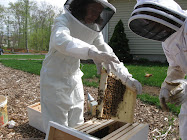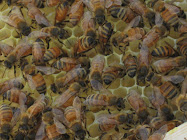.
First, I got started and inspired by The Real Food Revolution blogger. Check her site out.
Second, my first effort was a failure. Hey, it happens. I've made some bad bread and pie in my day too.
Third, I did some more research to see what I could have possibly done wrong and this is where I landed:
.
How to make your own Greek Style Yogurt
.
You need:
- 1 Gallon Milk
About 1/2 cup (or less) scoop of plain yogurt for your "starter" (must have "live active cultures")
1 Large Pan large enough to handle the gallon of milk
1 Candy Thermometer (or any thermometer that can measure liquids from 100 to 200 degrees F, a candy thermometer is nice b/c it clips to the side of the pan. - 1-2 heating pads
- 2 bath towels
- 1 large colander
1 large bowl that the colander can fit into - 1 large square of muslin, cheese cloth, or in a pinch a thin pillow case
- 2-4 very clean large glass jars with tops. Most people write that they are fine with jars cleaned very well with hot soapy water -- but you could sterilize them in your dishwasher if it has that feature, pour boiling water into them before filling while the yogurt is in the fridge draining, or actually go all the way and sterilize them in a boiling water bath. Your choice.
Directions (this really isn't hard ... at all -- my long winded-ness just makes it seem long and labor-intensive. It isn't!)
- Set 1/2 Cup plain yogurt starter aside at room temperature
- Put the gallon of milk into the pan and heat it to 185 degrees F over medium heat to kill of any "bad" bacteria -- stirring from time to time to prevent the milk from sticking (or worse) burning on the bottom of the pan.

- Remove the pan from heat -- and if you'd like to move quickly -- put the pan into an ice water bath in your sink with the top of the pan on -- thermometer sticking out of the side until the milk is brought down to 105 degrees F. If you use the ice water bath method it's really very fast. Otherwise, stick the pan on the counter and wait.
- Stir 1/2 Cup of the room temperature plain yogurt into the milk - well.
- Turn your heating pad(s) on medium heat and set them on the counter.
- Take your pan of 105 degree F milk with yogurt starter stirred in and put it on top of the heating pad. I put another heating pad (set on medium) on top of the pan (with the top on the pan, obviously), but this might have been overkill.
- Then, cover pan / heating pads with two towels, tucking in the ends to avoid drafts.
- Let sit for 12 hours -- over night is great. (I made mine during Ripley's nap -- set it to brewing at 3pm and woke up after a good nights sleep at 5:30am - perfect!) The longer the yogurt "brews" the better it is for you -- that good bacteria really gets going. As you pass the 12 hour mark the yogurt is supposed to taste tarter (not necessarily a good thing in my book). I "brewed" mine for 13 1/2 hours (because I was sleeping) and it isn't sour or tart at all -- go figure.
- In the morning - line your colander with your clean cheese cloth or muslin and set the colander inside a large bowl to catch dripping liquid -- or Whey.
- When you take the top off your pan and peek in, the yogurt should have formed into something that looks like a custard. There will also be a clear yellowy looking liquid on top and around the sides -- this is your Whey. (as in Little Miss Muffet ... you know) Pour as much Whey off as you can without dumping out your yogurt -- keep the Whey and use as you would buttermilk for baking, or if you're feeling adventurous -- homemade Whey Ricotta.
- Dump the sloppy yogurt into the cheese cloth / muslin that's inside the colander. Pull up the sides of the cloth, twist and tie a knot on the top so that the cloth is tight around the blob of sloppy yogurt.
- Put the Yogurt, cloth, colander, bowl into the fridge for 2 hours. I poured the Whey out of the bowl a couple of times to be sure it was draining well, but that might have been overkill.
- Spoon and scrape the yogurt the yogurt off the cloth and into clean jars.
- Chill in the fridge
- Serve with honey and homemade granola.
My sister-in-law Tanya (a Greek Yogurt connoisseur) taste tested and agreed that it was .... YUMOLA!!
Incidentally; Ripley, Benjamin and I are downing homemade granola and homemade yogurt like mad ... can you believe it?! Ripley, eating super good for you homemade granola? He even asked for it for lunch. I'm going to have to make more next week at this rate -- I'll take pictures and update this post. Good Luck!





































3 comments:
Yummy! Thanks Sandy, this is on my to-try list.
Fabulous step by step instructions!
Turned out beautifully, thanks.
I make this also, but:
I heat it to 80C/178F in a stew pot set into another that has water at the same level.
I add 2 packages of dry milk per gallon, minimizing whey.
I cool it fairly fast in a sink of water, to limit air bacteria.
Inoculation is from a good batch that I froze in ice cubes. I started with greek yogurt and later added another variety of bacteria.
I put the heating pot into a cooler warmed with hot water bottles and leave it for four hours, or until set. Summers, I put it into 110F water and put it in the sun.
I cool the pot and refrigerate overnight. There is no free whey & it's really mild.
I use some straining cloth, gotten from Dadant for honey straining, and triple it, strain it in the colander for from 24-48 hours, covered with plastic wrap. The middle is more liquid than the outside. It is as thick as cream cheese and used the same.
Seems like yogurt is very forgiving of technique, some even use unpasteurized milk without heating and incubate at all kinds of temps and times.
VirginiaCountryLife.Blogspot.com
Post a Comment